2017 has been crazy and we are only a few months in really with multiple big launches from AMD. They launched their RX 400 series of cards last June and the excitement and hype has hardly slowed down in AMD groups. Now that Ryzen 7 and 5 are both out and with rumors of Vega starting to pick up AMD decided to slip in the 500 Series launch. This might be one of the worst kept secrets with cards being sold worldwide for the past week or two but today is the day we finally dive into it all officially. For the launch, AMD sent over the latest Sapphire Nitro+ RX580 in an 8GB Limited Edition version. So today I’m going to run through what the 500 Series is all about and then I’m going to test the Sapphire card and see how it compares. For even more fun I dug out the RX480 Nitro+ that dominated our RX480 charts to see how the new card compares to its year older brother.
Product Name: Sapphire Nitro+ RX580 8GB LE
Review Sample Provided by: Sapphire
Written by: Wes
Pictures by: Wes
Amazon Link: HERE
RX580
So just to start things off, a lot of people thought and some still think that the 500 Series launch is AMDs Vega launch, that is not the case. This is, in fact, a refresh of the 400 Series of cards based on Polaris. Driver and software wise, the RX 400 cards have improved a lot from their launch and if you haven’t followed that you might be surprised at how they perform now. AMD is taking advantage of that improvement and bumping up clock speeds as well and rebranding the cards. That is why on our press call AMD used the terms Polaris Evolved and Polaris Enhanced. This slide in fact really summed it all up. Aggressive tuning for higher clocks, expanded options with a lot of partner designs, and enhanced idle and multi-monitor efficiency.
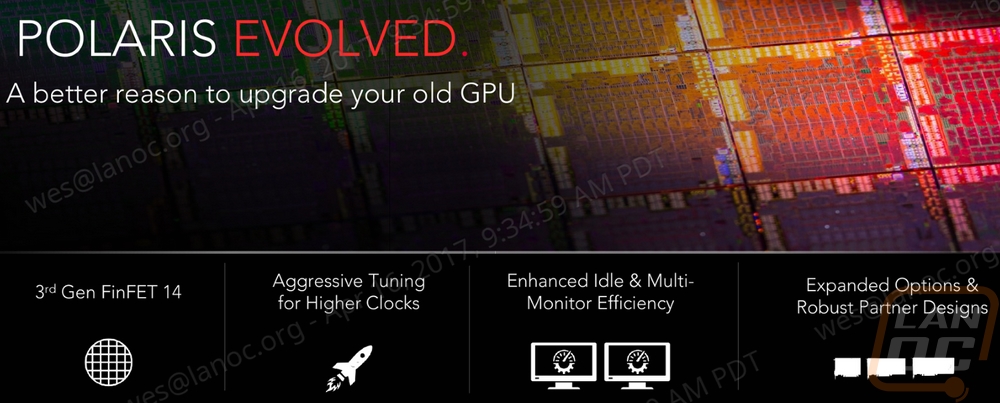
One of the big introductions a while back was Radeon Chill but it didn’t get very much attention. AMD has now expanded the games supported to include League of Legends and DOTA2 two of the most popular games played. Basically, Radeon Chill work in games that don’t need as much graphical power as other games like older games and the eSport focused games that will run on anything. They basically cap your framerates to lower power usage and keep your card running cool. The goal at least is to cap high enough where it isn’t noticeable so on the RX580 they are looking at between 60 and 144 FPS. They also claim quicker response times as well with fewer framing being queued.
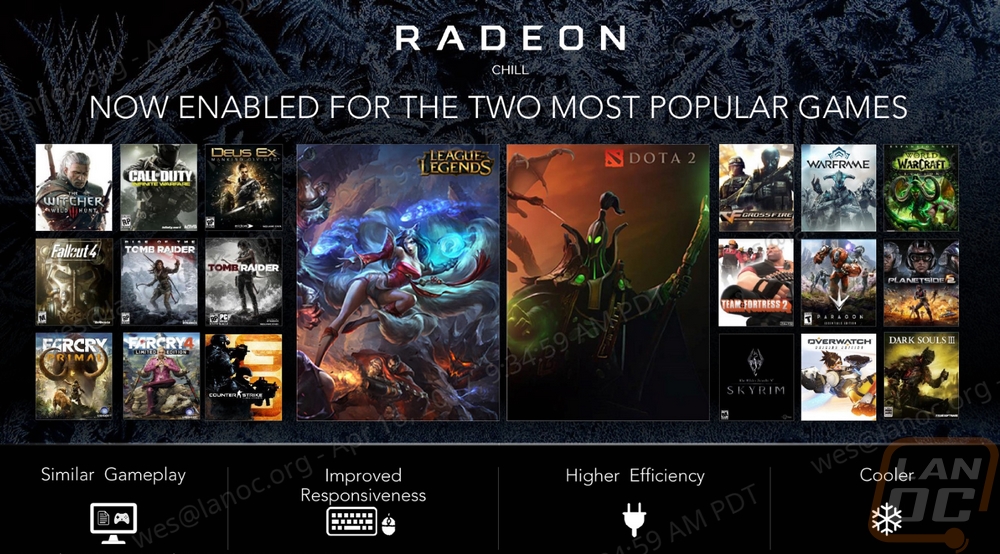

So here is the RX500 Series of cards. They are introducing the RX580, RX570, RX560, and RX550 replacing the similarly named 400 series cards.
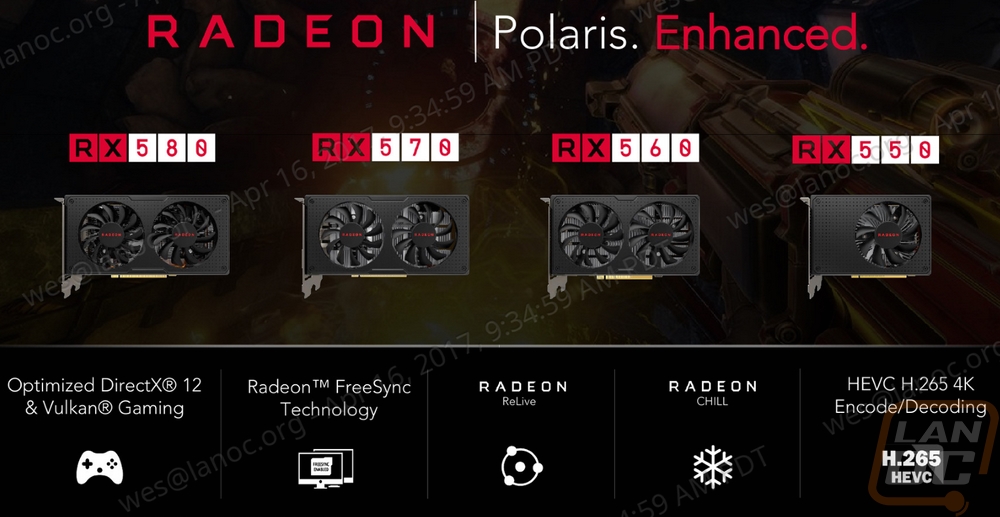
So the RX580 has the same 8 and 4 gig models as the RX480 had. Nothing changes for compute units as well with the same 36 compute units. The RX480, however, had a boost clock of 1266 MHz and a base clock of 1120 MHz where the RX580 at stock speeds has a base clock of 1257MHz and a boost clock of 1340MHz, not a bad jump. Now aftermarket cards will be pushing past that I’m sure.

The RX570 does a similar jump with the new clock speeds being 1168/1244MHz compared to the RX470 stock clocks of 926/1206. The base clock making an especially big jump.
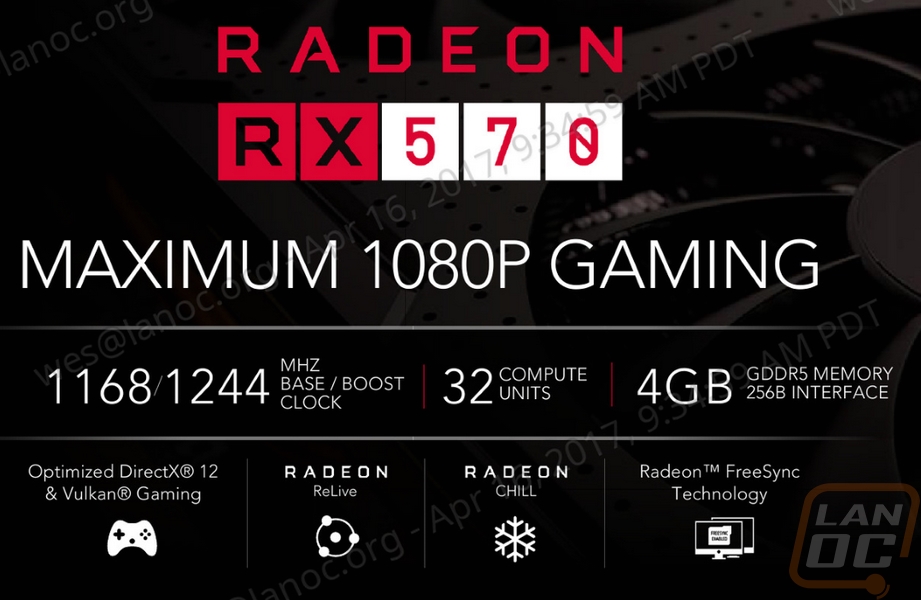
The RX560 takes the 1090 base clock and 1200 boost clock of the stock RX460 and bumps it up to 1175 base and 1275MHz.

The RX550 is a little more interesting because it doesn’t have a direct competitor from the RX400 series. It is a much smaller, single fan card with a 1183Mhz boost clock. It only has 8 compute units and 2 gigs of vRAM as an entry level card.
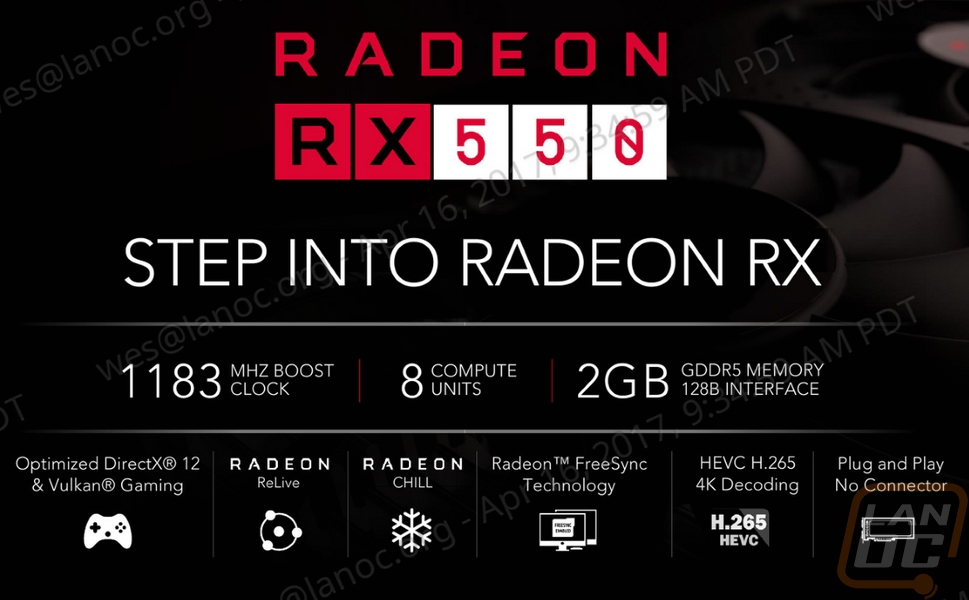
Here is a larger specification breakdown for the RX580 and RX570.
|
Specifications |
Radeon RX580 |
Radeon RX570 |
|
GCN Architecture |
4th Generation |
4th Generation |
|
Manufacturing Process |
14-nm FinFET |
14-nm FinFET |
|
Die Size |
232 mm² |
232 mm² |
|
Compute Unites |
36 |
32 |
|
Stream Processors |
2304 |
2048 |
|
Clock Speeds (Boost / Base) |
1340 Mhz / 1257 Mhz |
1244 Mhz / 1168 Mhz |
|
Peak Compute Performance |
Up to 6.17 TFLOPS |
Up to 5.1 TFLOPS |
|
Texture Units |
144 |
128 |
|
Peak Texture Fill-Rate |
Up to 193.0 GT/s |
Up to 159.2 GT/s |
|
ROPs |
32 |
32 |
|
Peak Pixal Fill-Rate |
Up to 42.9 GP/s |
Up to 39.8 GP/s |
|
Memory Size |
8 GB |
4 GB |
|
Memory Bandwidth |
256 GB/s |
224 GB/s |
|
Memory Interface |
256 bit |
256 bit |
|
Memory Type |
GDDR5 |
GDDR5 |
|
Board Power |
185W |
150W |
|
AMD FreeSync Technology |
Yes |
Yes |
|
DirectX 12 Support |
Yes |
Yes |
|
Vulkan Support |
Yes |
Yes |
|
Displayport Version |
1.3 HBR / 1.4 HDR Ready |
1.3 HBR / 1.4 HDR Ready |
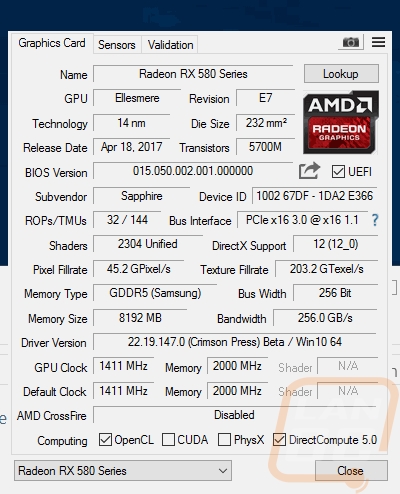
Packaging
Some manufacturers have stuck with the larger boxes that video cards used to have but recently Sapphire has focused on smaller boxes in most situations including the Nitro RX480 last year. So you can imagine my surprise when the Nitro RX580 came in this time around in a larger box similar to what Asus and MSI use. On a closer inspection though I did notice the Limited Edition designation and a note about this one coming with an extra set of fans, explaining the larger box. While I prefer a photo of the card on the cover any day to artwork, the Nitro robot on the cover here does look good, especially with that blue background and lights. Beyond that it has the Radeon RX580 branding, the Sapphire Nitro+ branding up in the top right corner, then a list of four features down along the bottom. The blue theme wraps around to the back where there is a small photo of the card. Beyond that, there is a basic specification list avoiding things like clock speeds and a feature list that runs through a few of the features like the extra blue LED fans, dual ball bearing fans, RGB LED indicators and many more features.


Inside when I opened everything up there is a foam panel across the top then the card was the next thing that greeted me. It comes in a foam cutout for protection. My sample didn’t have an anti-static bag around it, I’m not sure if this was because it was a pre-launch sample or if that is the plan going forward.

Then for accessories and documentation, you get a few things. You get an installation guide and a warranty card. There is a driver disc but I always recommend getting the latest driver online. Then there was a big box up under everything with the two fans inside in their own plastic clamshell cases.


Card Layout and Photos
So with the RX400 series of cards, there were only a few cards that I would consider to be good looking cards and the Sapphire Nitro cards were at the top of the list. Of course, not everyone felt that way, there were a lot of people who complained about the cheese grater look but personally, I think it has a nice clean look. For the RX580 the new Nitro+ card kept that same look but with a few changes. The new cards are a little larger, a little heavier, and they went with a gray finish over the black finish from before. None of the changes were big enough for them to be noticeable when you only have the new card in hand, but I tested this one against last year's model, having them next to each other makes it even more obvious.

The RX580’s gray finish is color neutral meaning it will fit in just about any build, especially if you are planning on using RGB lighting to set your build theme. The dual fan design with a completely enclosed top does make for a tall card though, you can see there is about an inch of space used above the top of the PCI slot cover. So none of the holes on the fan shroud go all the way through, they are there to help give the shroud a little style, same with the silver aluminum strip that goes across the middle. The RX580 Nitro+ Limited Edition has a clock speed of up to 1450 MHz and a memory clock of 2000MHz and the regular RX580 Nitro+ has a clock speed of 1411MHz, our card when checked in GPUz, however, had a clock speed of 1411MHz.



Now last years Nitro+ had a completely solid top for the cleanest possible look but it was at the cost of some cooling capacity as the power connection out the back took up cooling space and they had to go shorter on the heatsink to keep the heatpipes inside. Even though this card is slightly taller and longer, they did break into the top with the heatpipes this time around. Looking around the edges of the card we can see that the heatsink is thick and conforms to every part of the card, this isn’t a universal heatsink, and with the heatpipes protruding out the top and bottom, they packed as much into the space as possible. The four heatpipes help spread the heat out for the two fans to blow down and cool down. A lot of the air does go out the end of the card, the PCI slot doesn’t have much ventilation and the card isn't designed to vent out the top or bottom very much.



The backplate is full coverage with just a notch around the power connections. Last year I complained about this light silver, gray and black theme on an otherwise black card. With the shroud now having gray in it, it does fit better. I think I would still prefer just gray and black and to drop the brighter silver though, unless you used this in a build with one of the silver boards on the market now.

For power, Sapphire bumped things up. You might remember that for the RX480 the reference cards only had 6-pin connections when it should have been more. Sapphires Nitro+ had an 8-pin but this time they jumped up to an 8-pin and a 6-pin for even more power draw if needed. Given the bump in clock speeds, this isn’t a big surprise though.

For display connections, Sapphire went with a fairly unique dual DisplayPort and Dual HDMI configuration with one DVI port. Most cards anymore just have three DisplayPort then one HDMI and one DVI. Things are moving to DisplayPort but there are a lot of people who still are using HDMI or DVI so it is nice that they are keeping that in mind. From here we can see the half slot cooling vent as well. This is also a great view to check out the total height of the card over the PCI slot.

Last year Sapphire introduced the replicable fans but only used it for RMAs. This time around they kept them but went above and beyond and bundled a pair of blue LED fans with this limited edition model. So to test them out I swapped out the fans. You just have to remove one screw then they come right out. With the fan out we can get a better look at the fin density and overall size of the heatsink as well. For the RX480 Nitro+, there were big gaps at the top and bottom to fit the heatpipes but not this time. Not only that but the fins look very tight together, they may have packed a lot of cooling capacity in this card.


Before getting going on my testing I also took a look at the lighting with those extra fans and the top logo. Both in blue looks really good. The top logo is also RGB so you can change it up, I hope in the future Sapphire gets RGB fans as well, being able to change the color of those to match my build would look really good. For now, anyone with a non-blue build still has the stock black fans and the RGB logo though.
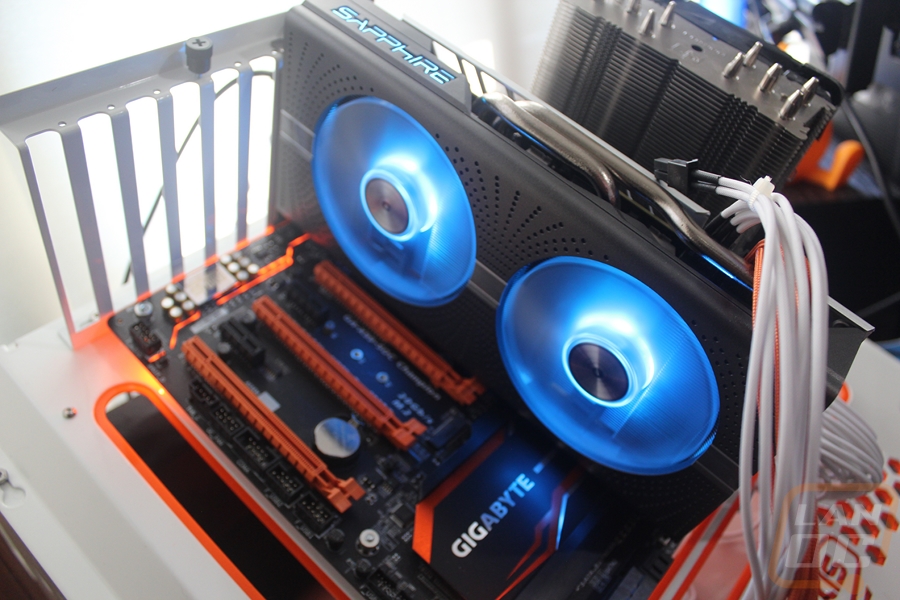
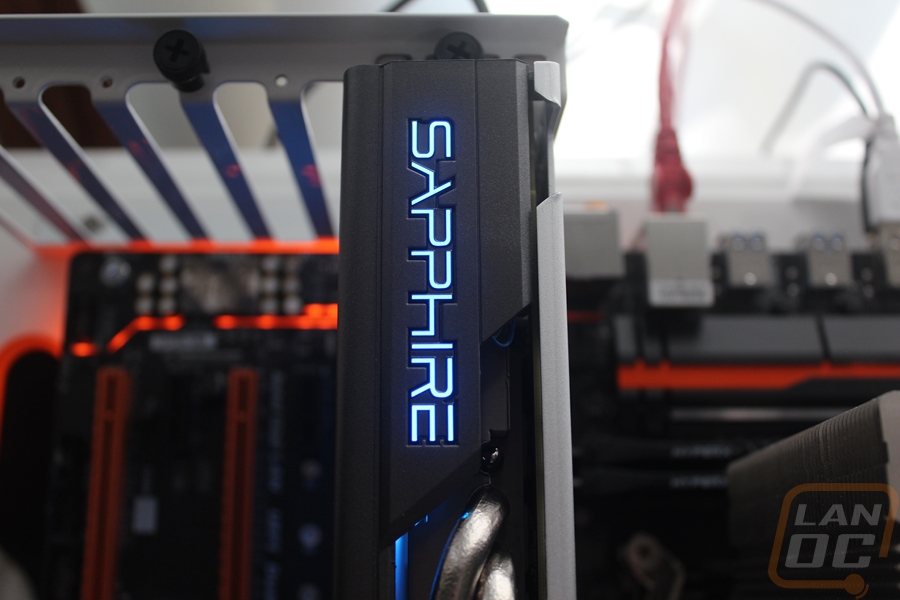
Our Test Rig and Procedures
|
Our Test Rig |
||
|
CPU |
Intel i7-5960X |
|
|
Memory |
Kingston HyperX FURY Black 32GB Quad Channel Kit 2666 MHz |
|
|
Motherboard |
Gigabyte X99-SOC Champion |
|
|
Cooling |
Noctua NH-U12S Cooler |
|
|
Power Supply |
Corsair AX1200w |
|
|
Storage |
Kingston Hyper X Savage 960GB SSD |
|
|
Case |
Primochill Wetbench |
|
|
OS |
Windows 10 Pro 64-bit |
|
|
Our Testing Procedures |
|
|
3DMark |
The same goes for the most current version of 3DMark using the Fire Strike benchmark in normal, extreme, and ultra settings. Tests are also run in the DX12 focused Time Spy benchmark as well. |
|
Unigine Superposition |
1080p Medium, 1080p Extreme, 4k Optimized, and 8k Optimized benchmarks all run in DirectX |
|
Unigine Valley Benchmark 1.0 |
Using the Extreme HD preset to get an average FPS |
|
Catzilla 4k |
Default tests for 1080p, 1440p, and 4k resolutions using the overall score for each as our result |
|
SteamVR |
Default SteamVR test using Average Quality score |
|
VRMark |
Orange and Blue rooms tested, use Average FPS for the result |
|
Ghost Recon Wildlands |
Ultra and High detail settings are used in the built-in benchmark run at 1080p, 1440p, and 4k |
|
Deus Ex: Mankind Divided |
Tests are done using the built-in benchmark at High and Ultra graphic settings at both 1080p 1440p, and 4k resolutions. |
|
DOOM |
Doom is tested on the Ultra quality setting. Tests are run at 1080p 1440p, and 4k using both OpenGL and Vulkan. The benchmark is a basic one using just the average FPS in the opening scene. |
|
HITMAN 2016 |
Fullscreen with V-Sync turned off Detail, Texture Quality, Shadow Maps, and Shadow Resolution all set to their highest settings. We test using both DX11 and DX12 at 1080p 1440p, and 4k. |
|
Ashes of the Singularity: Escalation |
Built-in benchmark ran at 1080p 1440p, and 4k with graphics settings set to the “Crazy” setting with the exception of turning off V-Sync Mode. The benchmark scenario is set to GPU Focused and we use the Average Framerate for All Batches as the result. Tests are run in DX12 |
|
The Division |
Built-in benchmark ran at 1080p 1440p, and 4k with graphics settings set to the default “Ultra” setting with the exception of turning off V-Sync Mode |
|
Total War: ROME II |
Ultra-setting tested at 1080p 1440p, and 4k, built in forest benchmark |
|
Middle-earth: Shadow of Mordor |
Using the built-in benchmark we test with ultra settings at 1440p and 4k |
|
Sniper Elite 3 |
Ultra-setting tested at 1080p 1440p, and 4k, built in benchmark |
|
Thief |
Tested using the “Very High” setting at 1080p 1440p, and 4k with V-sync off |
|
Passmark Performance Test 9 |
Test using the GPU Compute Score inside of Passmark’s Performance Test 9 |
|
CompuBenchCL |
Video Composition and Bitcoin tests |
|
Unigine Valley Benchmark 1.0 heat testing |
We run through Unigine Valley using the “Extreme HD” preset for 30 minutes to test in game cooling performance with the fan speed set to auto then again with the fan set to 100%. |
|
Power Usage |
Using 3dmark Fire Strike with the “performance” preset, we get our “load” power usage number from the peak power usage during our test. We get our numbers from a Kill-A-Watt connected to the test benches power cord. |
|
Noise Testing |
Our Noise testing is done using a decibel meter 18 inches away from the video card on the bottom/fan side of the card. We test at both 50% and 100% fan speeds. The 100% test isn’t a representation of typical in-game noise levels, but it will show you how loud a card can be if you run it at its highest setting or if it gets very hot. This is done using a Protmex PT02 Sound Meter that is rated IEC651 type 2 and ANSI S1.4 type 2. Tests are done set weighted to A and set to a slow response using the max function. The ambient noise level in the testing area is 33.3 decibels using the test settings. |
Synthetic Benchmarks
Being a new launch I took the time to go back through and relook at our benchmarks and change things up. For the synthetic benchmarks, this included adding the new Unigine Superposition benchmark and retesting all of our 3DMark Fire Strike results due to an update last week that caused older results to not be comparable to new results. For all of my retesting, I included a range of Nvidia cards going down to the GTX 1060 6GB using the founder's edition, of course, overclocked cards would be a better comparison though. Then for AMD, I retested using an RX470, the reference RX480, and the Sapphire RX480 Nitro+ for a direct comparison to today's card. As always synthetic benchmarks aren’t going to show you how well your card will perform in game, but they are a solid way to compare between cards so that’s what we are focusing on in this section.
Starting with 3DMark I tested using the Fire Strike benchmark in all three of the settings to test 1080p, 1440p, and 4k resolutions then I followed up with Tim Spy to check out DX12 performance. I wasn’t sure what to expect, even though the RX580 Nitro+ has a nice boost clock compared to the stock RX580 speeds and especially the stock RX480 speeds. The RX480 Nitro+ had a big overclock stock so the jump from 1342MHz to 1411MHz isn’t as large. That said the RX580 Nitro+ did still outperform the 480 Nitro and came in well ahead of the stock RX480 and GTX 1060 Founders Edition. In the two higher resolutions the GTX 1060 gained enough to pass the stock RX480 but the two Nitro cards were still ahead. In Time Spy we had more results to compare against and you can see that the overclocked GTX 1060 came in above the RX480 Nitro but the RX580 Nitro had a big lead still.




So I tested with the new Unigine benchmark and the older Valley Benchmark. In the older one, the RX580 came in 3 FPS ahead of the previous Nitro card, inching closer to the GTX 780 on that test. Valley Benchmark favored Nvidia cards more so the GTX 1060’s were all up higher in the list. For the new Superposition benchmark, I decided to test across four different benchmarks. The two 1080 results are what I want to focus on, the 4k and 8k results were just slipped in for future reference. So here the RX580 Nitro once again outperformed both 480’s but the GTX 1060 Founders Edition performed surprisingly well with a slightly higher score in the 1080p medium benchmark. Both Nitro RX480 and RX580 tests outperformed when it came to the 1080p Extreme benchmark though.


For my last tests, I ran through Catzilla benchmark at 1080p, 1440p, and 4k. Like the Unigine tests, the GTX 1060’s were ahead by a significant amount on all three tests. Beyond that, the RX580 Nitro+ did still pull a good lead out on the RX480 Nitro+ and the XFX RX480 as well.



VR Benchmarks
So our synthetic benchmark section has grown to the point where it couldn’t fit our VR benchmarks anymore. The goal is to expand this coverage more but for now, we just have a few tests that I’m testing for. The SteamVR benchmark is a free benchmark from Valve that takes a basic look at performance and puts each card in three categories. The red is a no go, yellow is okay, and green is good. It’s no surprise that the RX580 Nitro+ was in the green, the older RX480’s were also good for VR. It did gain an extra .3 over the RX480 Nitro+ though, not bad!

As for VRMark. This one takes a closer look at VR performance across two different tests. The Orange room is similar to what you see for demands with today’s VR games the blue room is future looking to more demanding games. With 120 FPS being needed for ideal gameplay the RX580 Nitro+ performed extremely well, coming in well above both the GTX 1060’s and the RX480’s. The 1060’s did perform a little better in the blue room results but really none of the cards including the 1080 Ti are enough to really push that test yet.

In-Game Benchmarks
As always, in game benchmarks are what we all want to see. Our in-game benchmark test suite did see some big changes. For one, I removed a few of the extremely old games as I have been adding new replacement games for them for a while now. I also added in the new Ghost Recon Wildlands as well. Then across all of our game benchmarks, I retested everything, adding in 4k testing into the mix. Then for Ashes of the Singularity, I switched to the new version as well. In total, we are testing 10 games but with the three resolutions and for a few games I test across two detail levels or things like DX11 and DX12. In total each card is tested 41 different times. With all of those results, I found it easier to break things down into one graph for each resolution for an overall look at the results. So the graphs below show what FPS range each test came in to get a feel for how playable each of the games is. Keep in mind every game tested is run at its highest settings. I include below 30, over 30, over 60, and over 120 in the graphs. Over 60 is ideal but over 30 is playable, the new over 120 FPS results are there for people looking to play at higher refresh rates.
So how did the RX580 Nitro+ perform? Well, the RX580, like the RX480 isn’t a 4k focused card at all so those results aren’t really important though I was surprised that a majority of the games were still playable. Moving down to 1440p the RX580 did even better with everything but one game being playable and half being in the 60+ range. Then at 1080p it basically stomped everything. The slowest games were in the 30-59 FPS range but almost everything was 60 FPS or more with two even being ideal for 120+.



Of course, I wouldn’t just leave those results without actually including our actual results for those crazy enough to reach through them all. This is especially crazy because I have our old test results prior to adding 4k into the mix as well so below is just a crazy number of graphs, reach at your own risk lol. Was there anything interesting? Well, the first results from Wildlands were surprising, the RX480 Nitro+ actually outperformed the RX580 Nitro+, I can only imagine that this is driver related as the RX480 is tested on the latest driver and the RX580 was tested on a press only launch driver. Wildlands also favored the GTX 1060 but it is a Nvidia supported game. The DOOM results are always impressive for AMD cards as well when you compare the OpenGL to Vulkan results, the RX580, for example, went from 90 to 138 FPS. Beyond that, the results were about what was expected. The RX580 Nitro+ is faster than all of the RX480’s tested and it is faster than the GTX 1060 FE in most cases.

























Compute Benchmarks
Most of us pick up our video cards specifically for gaming, but there are times where we will sometimes take advantage of having them in other workloads as well. That’s why I like to take a minute to check out the overall compute performance on top of everything else. Normally I like to use Folding at Home but given the Nvidia driver issues for months now I decided to switch things up. I’m also open to other workloads if people have them. But for now, I added in a new test using Passmark’s Performance Test 9. In the 3D test, they have a specific test for GPU Compute so when testing everything I tested in it. It is obviously a single precision test because the Nvidia cards are all at the top. This is why I liked FaH because I could test both double and single precision workloads. Anyhow, I was surprised that the RX480 Nitro pulled ahead here and like similar results in one of our other tests I wonder if it is driver related.

In the CompuBenchCL benchmarks though the RX580 Nitro+ really took off. In the Video Composition benchmark, it came in only behind the GTX 1080 Ti. It’s clear that AMDs driver improvements have really helped in that benchmark. Even in the Bitcoin mining benchmark, it was up just below the GTX 1070’s and out ahead of all of the RX480’s and WELL ahead of the GTX 1060.


Cooling, Noise, and Power
The last section of testing really focuses on all of the areas that companies like Sapphire have a bigger role in beyond just cranking up the clock speeds. I like to take a look at things like power usage, noise, and temperatures to get an idea of how cards with the same GPU compare. Right now the Sapphire card is the only RX580 tested, but in the near future, there will be more.
To start things off let's take a look at power usage. This is an area where the RX480 Nitro+ struggled, it pulled a lot more juice than other RX480’s. With even more of an overclock and now with two power plugs I wasn’t really surprised that this number went up a little. Now keep in mind these are the overall numbers for our entire system while in 3DMark so it includes CPU usage as well. So at 352 watts, it is high up our charts but it’s not like you are going to need a 1000 watt power supply to power things. But keep in mind it is pulling 20 more watts than even the GTX 1080 FE and only the GTX 1080 Ti is pulling more out of the cards tested.

Next, I wanted to check out overall fan noise. To do this I tested 50 and 100 percent fan speeds using our new decibel meter at a distance of 18 inches. The Nitro+ like most modern cards doesn’t run its fans most of the time so idle noise would just be our room level so I force the two fan speeds to get a range. The RX580 Nitro did extremely well at 100% but was a little loud at 50%. This was in line with the max fan speeds I saw as well with the card running nearly the lowest overall RPM when compared to the other cards tested.


The last test was to take a look at cooling temps. I like to take a look at two aspects, with the stock fan profile and then again with the fans cranked all the way up. The stock profiles are tuned to balance temperature and noise so the second test shows what the cooler is capable of if pushed. To heat things up I use Valley Benchmark for a medium load to replicate in game temps while being loopable. So with the stock fan profile, the RX580 Nitro+ fell in the middle of our chart right in the same area of the previous generation Sapphire cards. This is a little higher than I would prefer but this is also going to be a hotter running GPU as well given even higher clocks and a high power draw. When the fans were turned up though the new larger cooler design really did well running at 50 degrees under load. That’s a big drop and put it down lower than last years RX480 Nitro+ in the same test.
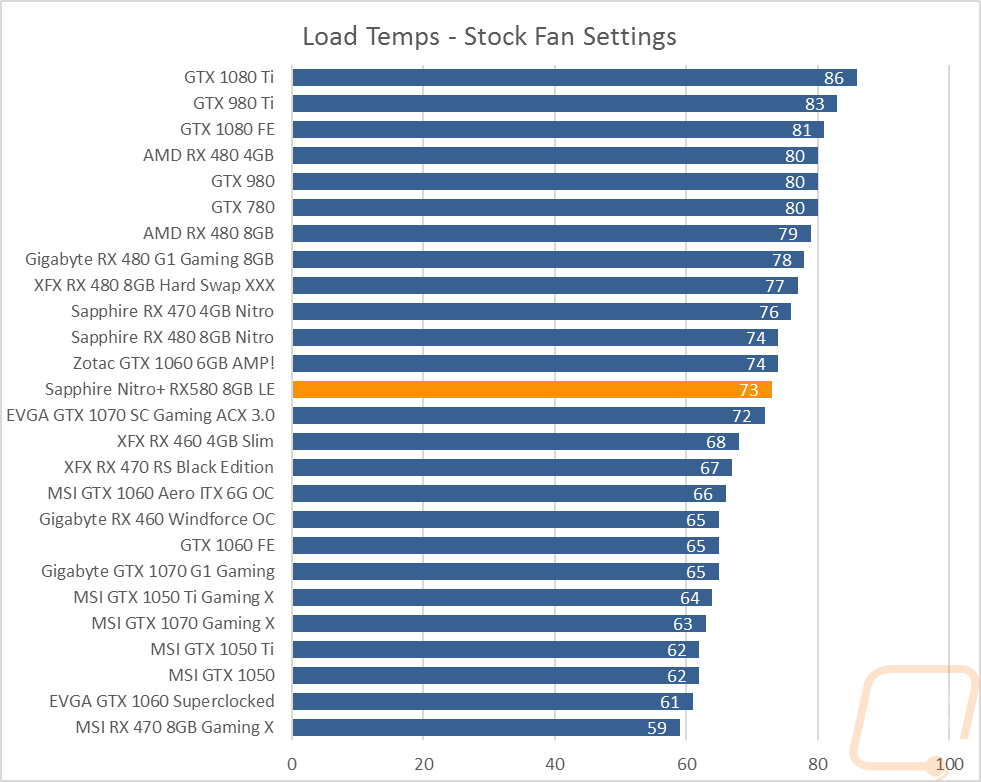
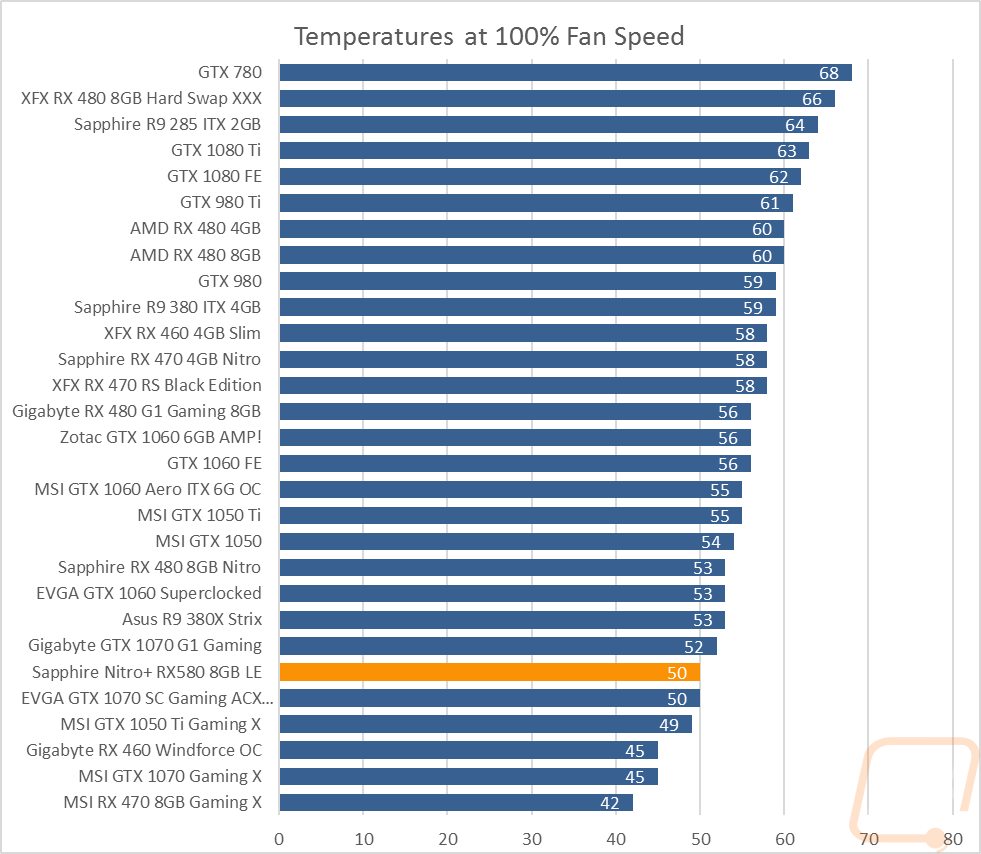
Overall and Final Verdict
So the RX500 series launch is an interesting one. For those of you who picked up RX480’s last year, this isn’t really the launch for you if that wasn’t obvious already. But for those who were still holding out, this is a nice jump up when coming from 300 series cards or 700 or 900 series from Nvidia. While I need to test other cards to really confirm, I’m expecting the Sapphire RX580 Nitro+ that I tested today to be at or near the top of the charts for performance just like they did with the RX480 Nitro+. They managed to squeeze out even more clock speed from the already big bump from AMD and they took the design from last year and improved on it. It looks a lot like the RX480 Nitro+ but with a new Gunmetal finish on an overall larger cooler. They really packed in the cooling this time where last time you could see big gaps.
I know the aesthetic is really dependent on preference but I dig it just like I did last time and that bright silver backplate doesn’t look as out of place on the gunmetal cooler as it was in the black finish. You get an RGB logo up top and a glow on the back of the card as well that is RGB. The fans are also replicable and with the Limited Edition model tested today you get a second set of fans that were blue in color to match their new Nitro+ blue look. They look great, I only wish I could get RGB on the fans as well to make the whole card match your build no matter what.
The performance was great compared to the RX480 launch partially due to the much higher clocks and improvements in the AMD drivers over the past year as well. This put the RX580 Nitro+ up ahead of last years Nitro+ in nearly every test but a good margin. The GTX 1060’s have improved as well in performance over the year and with that, they do still trade blows but overall the RX580 Nitro+ does win out. You pay for that with power draw that is more than the GTX 1080. Beyond that, the stock fan profile runs a little warm but in our other testing, the card proves that it has the cooling capabilities when pushed so an adjustment of the fan profile to match your tolerance for noise is all that is needed to keep it running cool.
Only time will tell if the Sapphire RX580 Nitro+ will become the best RX580 in the market, I’m planning on testing a few more RX580’s so we will know soon. But right now it is looking good. Sapphire improved on the RX480’s design while sticking with the high clock speeds. You do have to keep in mind the power draw, but unless you are planning a SFF build it shouldn’t be anything you can’t handle. Now is the Limited Edition model the one to pick up? If you are doing a blue build you get the blue fans and there is a little extra clock speed. If not I would be looking at the normal Nitro+ RX580 as it is $20 cheaper.
*Update* All of our testing was done at 1411MHz. The Limited Editon card is capable of 1450MHz with the BIOS switch flipped and we didn't know this prior to the launch. I hope to be able to circle back around and get updated numbers later with launch drivers.


Live Pricing: HERE




